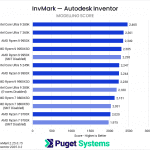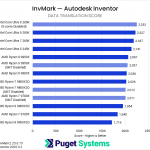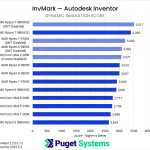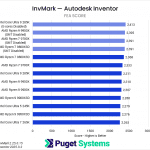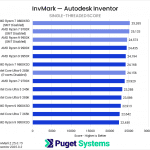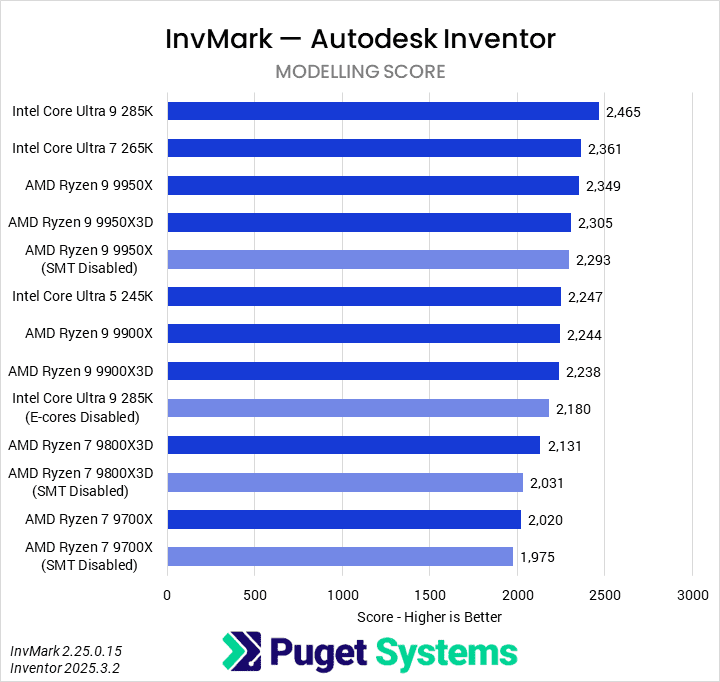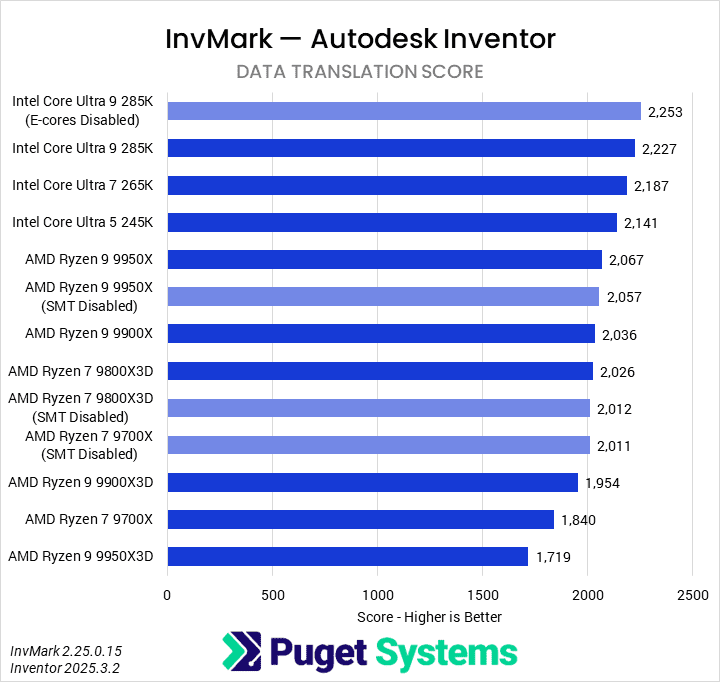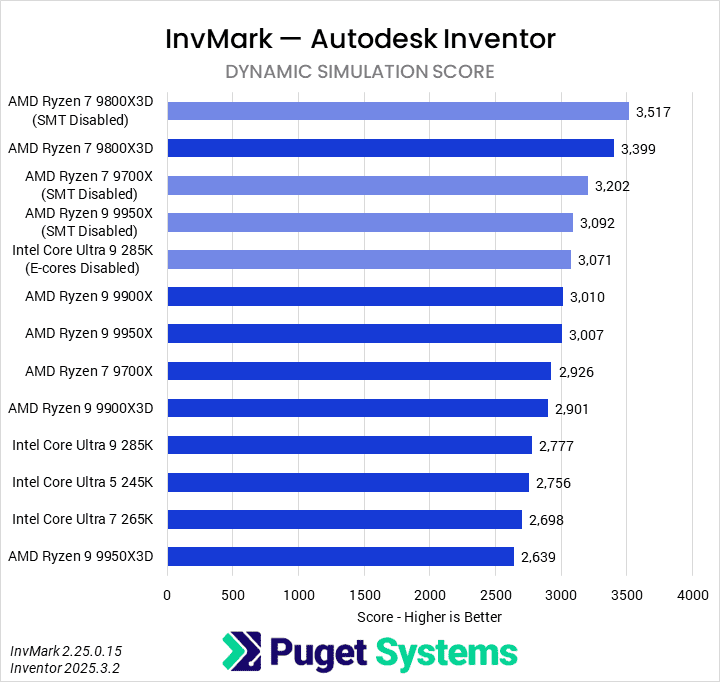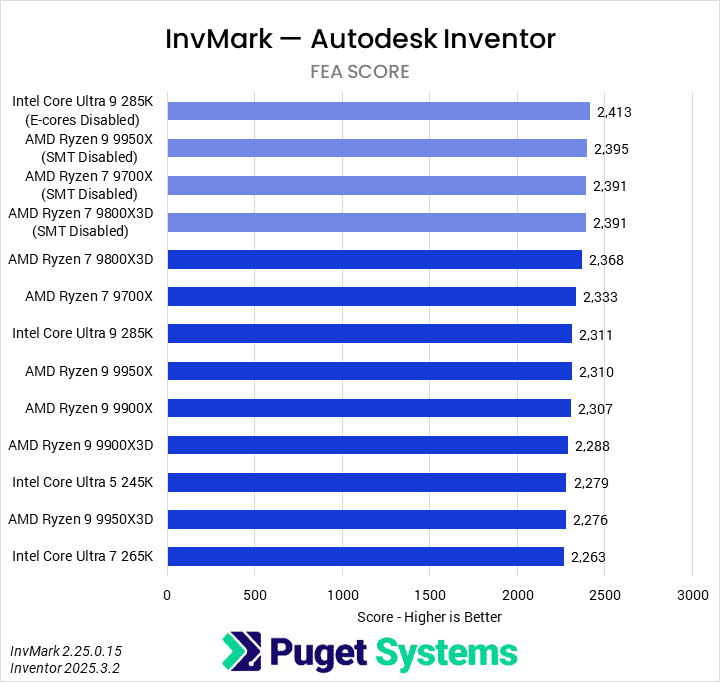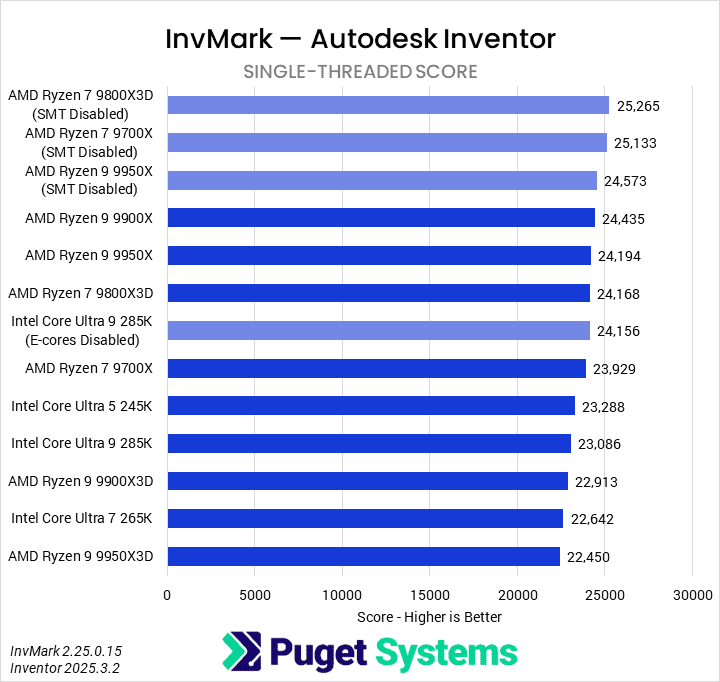
Hardware Recommendations for Autodesk Inventor
Official system requirements for Inventor really just address minimum hardware specs, not what gives the best performance. We put together our recommendations and answered common questions below.
Autodesk Inventor System Requirements
Quickly Jump To: Processor (CPU) • Video Card (GPU) • Memory (RAM) • Storage (Drives)
Like most software developers, Autodesk maintains a list of system requirements for Inventor that can be used to help ensure the hardware in your system will work with Inventor. However, most “pc requirements” lists tend to cover the required hardware, not what hardware would actually give the best performance. In addition, some lists can be outdated, list old hardware revisions, or simply outright list sub-optimal hardware.
Because of how inconsistent those lists can be, we’ve taken the time to perform testing to determine what hardware runs Inventor the best. Based on this testing, we have come up with our own list of recommended hardware for Inventor.
Processor (CPU)
When it comes to CPUs there are two main specifications that define the capability of a CPU:
- The frequency directly affects how many operations a single CPU core can complete in a second (how fast it is).
- The number of cores is how many physical cores there are within a CPU (how many operations it can run simultaneously).
Whether a higher frequency or higher core count is faster depends on how well a program is designed to take advantage of multiple CPU cores.
What is the best CPU for Autodesk Inventor?
In the case of Inventor, the majority of the software is only single threaded so it is only able to utilize a single core of the CPU. For this reason, our general recommendation when choosing a processor is to get the highest frequency. For current generation CPUs, that is Intel’s Core™ Ultra or AMD Ryzen™ 9000 Series, both of which offer high clock speeds alongside a good number of cores. The trade off on exactly which is the best depending on the task within Inventor, but Intel’s Core™ Ultra 9 285K leads in both modeling and data translation benchmark results.
There are a handful of specific tasks in Inventor that are able to use more than one core (a list is available here), but CPUs like those recommended above have several cores and will generally do quite well there too. If you spend a lot of time with either rendering or FEA simulations, though, there can be reasons for going to an even higher core count. For those situations, we offer a workstation with AMD’s Ryzen™ 9 9950X with 16 full-speed cores. The Ryzen™ 7 9800X3D with its extra, high-speed cache also does very well in smaller simulations.
Does having more CPU cores improve Inventor performance?
Designing and modeling in Inventor is not able to utilize more than a handful of cores. We have found that a CPU with the highest operating frequency will give you the best overall performance for general modeling tasks. Intel’s mainstream Core Ultra processors currently offer very high single-core clock speed, without a high price tag, so that is our go-to recommendation. Rendering with the built-in engine, however, can see moderate to large performance gains with a higher core count CPU. For that reason we use AMD’s Ryzen processors with up to sixteen cores for our rendering-optimized Inventor workstation.
Do I need a Xeon CPU for Inventor?
In the past, Xeon CPUs were more robust than their Core-series counterparts. Today, however, there is very little functional difference between the two Intel product families for software like Inventor. Moreover, Xeons are almost always clocked at lower speeds than the Core series – which directly impacts performance. Xeon CPUs do support ECC memory, but while that is a nice feature it is certainly not essential.
Should I get an overclocked system for Inventor?
In general, we do not recommend overclocking for any professional workstation. Typically, the modest performance gains are not worth the downsides associated with overclocking which can include instability, shorter hardware lifespan, and potential data inaccuracies.
Video Card (GPU)
The video card handles displaying the 2D and 3D models on the screen in Inventor. While mainstream GeForce cards can technically give you better performance per dollar, Autodesk only officially certifies and recommends workstation cards such as those in NVIDIA’s professional RTX series product line. Because of this, we highly recommend using certified cards in any professional environment to ensure that you will be able to get full support from Autodesk if you ever have a software issue.
What video card (GPU) is best for Autodesk Inventor?
In most situations, the faster the video card the better performance (in terms of frames per second) you will get when working with 3D models and assemblies. In general, the RTX™ 2000 Ada 16GB is a good starting place for small assemblies, while the faster RTX 4000™ Ada 20GB is great for mid-size projects. If you work with more complex assemblies, you might want to consider the RTX PRO™ 5000 Blackwell 48GB. The top-end RTX PRO™ 6000 Blackwell 96GB is overkill for all but the very largest projects.
Do I need to use an RTX PRO (formerly Quadro) card for Inventor or is GeForce okay?
Autodesk only certifies Inventor to run on a short list of tested video cards, which primarily include NVIDIA’s RTX PRO™ models and older Quadros – though that brand name is no longer used on current generation cards. In the past, we did not find any major performance difference between GeForce and professional cards in our limited testing, but we do advise following Autodesk’s guidelines so that if you have any problems and need their support you won’t be stopped by having an uncertified card.
Memory (RAM)
How much memory (RAM) does Autodesk Inventor need?
While the exact amount of RAM you need is going to depend on the size and complexity of the model you will be working with, we generally recommend the following:
- 32GB for most users
- 64GB of RAM for larger assemblies or heavy multitasking
- 128GB of RAM for heavy rendering or simulation workloads
Keep in mind the needs of any other software you run alongside Inventor, as those programs will need memory space as well.
Storage (Drives)
What is the best type of drive to use for Autodesk Inventor?
Thanks to their speed and relatively affordable price, we strongly recommend solid-state drives (SSDs) for the primary drive that will host your OS and the installation of Inventor itself. The high speed of SSDs allows your system to boot, launch applications, and load files many times faster than any traditional hard drive. In particular, the newer NVMe type of SSDs utilize the latest connections like M.2 and offer the fastest transfer rates.
If your budget allows, it is also a very good idea to have a second SSD that can be used to store your active projects to further decrease load and save times. We highly recommend using an OS drive with a capacity of least 500GB to ensure you do not need to upgrade your primary drive (which is often a complicated process) in the near future.
Will a solid-state drive help me open and save assemblies faster in Inventor?
Yes! SSDs are much faster than traditional hard drives and in many cases can give a noticeable decrease in the time it takes to open and save projects. SSDs also improve the overall responsiveness of a computer, and since Inventor files are not very large even a mid-size SSD should have plenty of capacity.
What sort of drive is best for data storage and backup?
Since SSDs are still more expensive than platter drives per GB, for long term storage and backup we recommend using a traditional hard drive or even an external drive array. Network attached storage systems are a great way to go for that, as they can be shared between multiple workstations and usually offer features to provide some level of data redundancy (protection against losing files if one of the drives dies).

